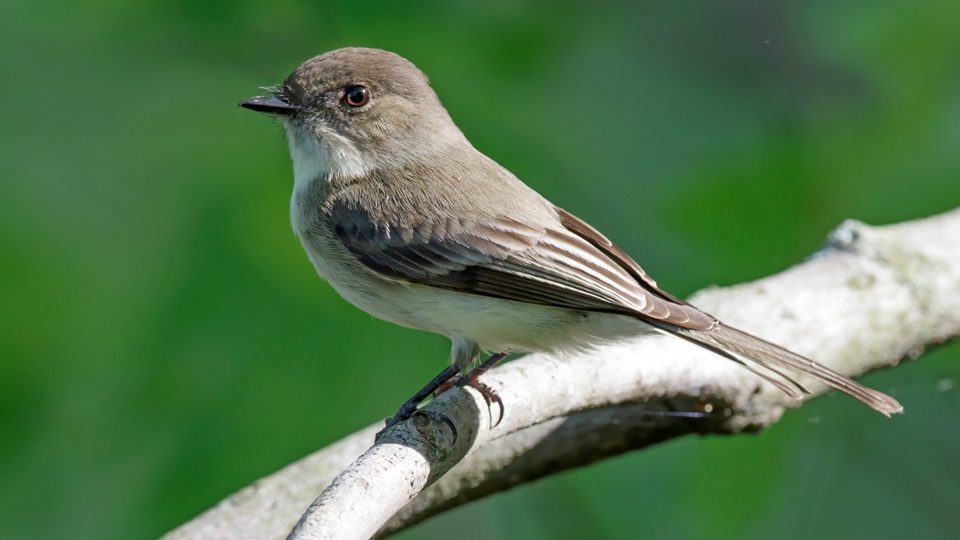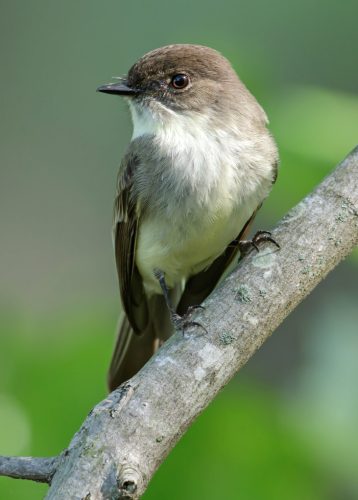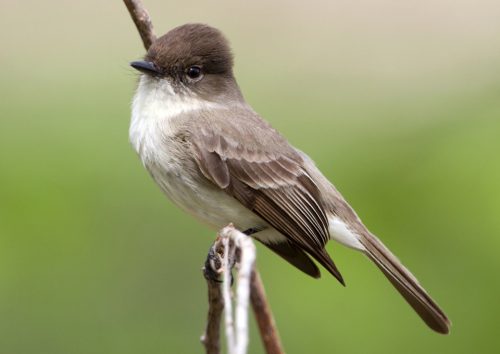Romanced by a Phoebe
A sure sign of spring is when the eastern phoebe goes a-courtin’.


Each spring he serenades me in gray tails, a creamy shirt, and a gray cap. His brown eyes are hopeful. He uses our courtyard as his amphitheater, where his voice broadcasts across the front of our property. He moves to the back of the house, sits on a balcony railing, and sings again. He will not be ignored. Every spring he comes to draw me in, to captivate me. This year he showed up the second week in March.
Interestingly, I am not alone. Many people all over the northeastern half of the United States and into northwestern Canada are being approached by a similar suitor, a species if you prefer, a bird, the eastern phoebe (scientific name Sayornis phoebe), especially if they live near water, stream, or riverside with a wooded edge. Another requisite is an overhang—a porch or a bridge. Here they nest on ledges and corners.
Eastern phoebes are one of the birds that have evolved to adapt to man’s mark on the landscape, making use of human-built structures. But they will also use naturally occurring rocky outcrops near riverbanks and cave entrances.
Admittedly he is not really calling to me even though he never fails to get my attention. His repertoire involves two main variations of “fee-bee” and “fee-b-be-bee.” Ornithologists call these “regularly repeated vocalizations” and for the eastern phoebe they are termed case RR1 and RR2. These he belts out with mixed variations. Occasionally he raises his head feathers, transforming his smooth head into a crest. It appears to me that this raised crest is a response to a concern. When they are seemingly relaxed it is possible they are simply showing off. However this heightened alertness adds to their visual appeal and formidable character. Although eastern phoebes are only 5 ½ inches to– 6 ¾ inches with a wingspan of 10 to 11 inches they have a stately presence.
He is actually calling for a mate. She too can sing but does so only rarely and briefly. Both sexes will call a “clear, sweet, weak ‘chip’ ” (Farrand 1983). The male will sing until he is paired with a female, and after that they will be monogamous throughout the breeding season. Exceptions are rare, and in fact the same pair may breed at a site in consecutive years.
After they pair they will proceed to select a nesting site. In our case they have chosen to build under the raised deck on the river side of our home. Between our house and the river is a buffer of woods that provides all the main habitat requisites the species seeks. For food they will eat fruits and berries in colder months but they are primarily insectivorous during their breeding season. A member of the flycatcher family, the eastern phoebe relies chiefly on insects—ants, flies, ticks, bees, dragonflies, moths, and the like.
In addition to claiming the railing and the courtyard, our suitor flies from tree to tree shouting his “fee-bee” and “fee-b-be-bee” in what I presume to be a territorial declaration, “This is my area, so listen up!” The repertoire of communication includes mandible snapping; this is not a bite but a sound and it is said to have startled many a “ringer” (what the English call a person who bands birds).
When selecting a nesting site the male will advertise a vacancy by chattering and fluttering near the new area. If it’s a returning couple possibly this is merely perfunctory, or maybe it is simply part of a compulsory ritual. These birds are commonly known to live three to four years, but popular lore calls out a 10-year-old that was banded in Iowa in 1979 and found in Alberta, Canada in 1989.
We have had a nest under our deck most of the 40-plus years that we have lived along the Maurice River. Selecting a location isn’t a heavy lift since eastern phoebes will often make use of the same site in successive years. At times they may also borrow a robin or barn swallow nest.
Each spring through summer, phoebes may raise two broods. One year we witnessed a black snake predate on the eggs and I suspect that was not the only time this has happened. Other known predators include raccoons, chipmunks, mice, crows, jays, and house wrens. Their greatest threat is thought to be the cowbird, which lays an egg in a different species’ nest for surrogate parenting. Rearing this chick is commonly at the expense of the true owner’s young.
 Eggs are laid and incubated for 16 days, and after hatching the chicks will fledge in the same amount of time. A clutch is typically five eggs. One to two weeks after the chicks have left the nest the female will lay a second clutch and the process will begin over again.
Eggs are laid and incubated for 16 days, and after hatching the chicks will fledge in the same amount of time. A clutch is typically five eggs. One to two weeks after the chicks have left the nest the female will lay a second clutch and the process will begin over again.
It is estimated that over 16 days’ time adults make 600 to 1,000 trips with food. As the chicks grow the nest will be bursting at the seams, so that the chicks must hang on the side to exercise their wings in preparation for flight.
A number of birds like to use a perch before entering their nesting location—a place from which they can check whether things are “all clear.” This surveillance is also an effort not to give away their nesting location to a possible predator. At our home the birds use the railing of our elevated deck to scan the area before making a food delivery.
Many birds hop or make short flights from limb to limb. Phoebes tend to move primarily by direct flight. To enter the nest they typically make a low swoop near the ground with an upward arc into the nest.
Outside of breeding season phoebes are primarily loners, having little contact with their own species. Many birds learn their song from conspecifics (others of their species), yet laboratory experiments show that eastern phoebes know theirs innately.
I hope that each year my imagined courtship by an eastern phoebe continues, since for me it has become a rite of spring as much as the appearance of the first daffodil. n
Sources
- CornellLab Birds of the World website
- AnimalDiversity.org
- iNaturalist









